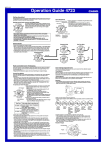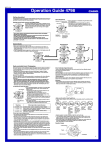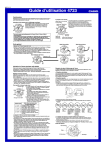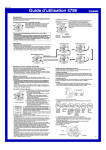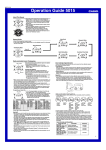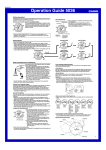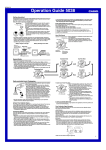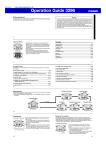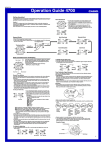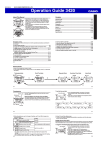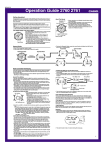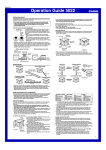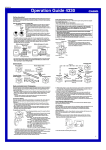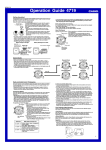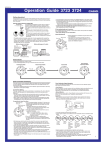Download Casio MO0712-EC User's Manual
Transcript
MO0712-EC Operation Guide 4722 Getting Acquainted Congratulations upon your selection of this CASIO watch. To get the most out of your purchase, be sure to read this manual carefully. About This Manual Stopwatch 1/20 second hand • Button operations are indicated using the letters shown Starting second hand movement and digital display Minute hand TAC HY ME TE Hour hand R TAC HY ME TE in the illustration. • Each section of this manual provides you with the information you need to perform operations in each mode. Further details and technical information can be found in the “Reference” section. R To conserve battery power, the watch is shipped from the factory with its functions disabled. Pressing any one of the watch’s three buttons will activate its functions, which will cause the second hand to start moving and the digital display to activate. Date This watch does not have a Time Zone that corresponds to the Greenwich Mean Time differential of –3.5 hours. Because of this, the radio-controlled atomic timekeeping function will not display the correct time for Newfoundland, Canada. 24-Hour hand Stopwatch minute hand Second hand(Timekeeping/ Stopwatch) Your watch switches automatically between Standard Time and Daylight Saving Time (summer time). Note, however, that switching cannot be performed correctly if the watch is not able to receive the time calibration signal. If you notice that the current time is not displayed properly, use the procedure under “To perform manual receive” or “To set the time and date manually” to correct it. General Guide Stopwatch Mode Dual Time Mode ▲ ▲ • Press C to change from mode to mode. • About 1.5 seconds after you enter the Dual Time Mode, Alarm Mode, or Hand Setting Mode the hands will move the position that indicates the current setting of the mode. You cannot change to another mode while the hands are moving. To change to another mode, either press C before the hands start to move, or wait until the hands stop before pressing C. • In Timekeeping mode (except when a setting screen is on the display), press B to illuminate the face of the watch. Timekeeping Mode TAC HY ME TE Press C. Hand Setting Mode Alarm Mode ▲ ▲ ▲ R Radio-controlled Atomic Timekeeping This watch receives a time calibration signal and updates its time setting accordingly. The time calibration signal includes both Standard Time and Daylight Saving Time (summer time) data. • This watch is designed to pick up the time calibration signal transmitted in the United States (Fort Collins, Colorado) and the time calibration signals transmitted in Japan. • The U.S. time calibration signal can be picked up by the watch while in North America*. * The term “North America” in this manual refers to the area that consists of Canada, the continental United States, and Mexico. Current Time Setting This watch adjusts its time setting automatically in accordance with a time calibration signal. You can also perform a manual procedure to set the time and date, when necessary. • The first thing you should do after purchasing this watch is to specify your Home Time Zone, which is the time zone where you will normally use the watch. For more information, see “To specify your Home Time Zone” below. • When using the watch outside the range of the time signal transmitter, you have to adjust the current time setting manually as required. See “Timekeeping” for more information about manual time settings. ll lll To specify your Home Time Zone 1. In the Timekeeping Mode, hold down A until the GMT DST indicator differential value starts to flash, which indicates the setting screen. • The second hand will move at high speed to the 12 o’clock position, where it will stop. • The GMT differential value indicates the time difference in hours between Greenwich Mean Time lllll lll and the currently selected time zone. • The DST indicator indicates that Daylight Saving Time (summer time) is turned on for the currently selected time zone. GMT differential • Selecting –5.0, –6.0, –7.0, –8.0, –9.0, –10.0, +8.0, or +9.0 ( –4.0, –5.0, –6.0, –7.0, –8.0, –9.0, +9.0, or +10.0 while DST is turned on) as your Home Time Zone automatically turns on auto receive. When auto receive is turned on and you are within the reception range, the watch will automatically receive the time calibration signal from the applicable transmitter (in the middle of the night) and update its settings accordingly. For information about the relationship between time zones (GMT differential values) and transmitters, see “Home Time Zones and Transmitters”. • See the maps under “Reception Ranges” for information about the reception ranges of the watch. • If you are in an area that does not use Daylight Saving Time (summer time), turn off the DST setting. • Even if the time calibration signal is received correctly, there are some times when the analog hands may not indicate the correct time. If this happens, use the procedures under “Adjusting the Home Positions” to check the home positions of the hands, and make adjustments as required. Time Calibration Signal Reception There are two different methods you can use to receive the time calibration signal: auto receive and manual receive. • Auto Receive With auto receive, the watch receives the time calibration signal automatically up to six times a day. When any auto receive is successful, the remaining auto receive operations are not performed. For more information, see “About Auto Receive”. • Manual Receive Manual receive lets you start a time calibration receive operation with the press of a button. For more information, see “To perform manual receive”. Important! • When getting ready to receive the time calibration signal, position the watch as shown in the nearby illustration, with its 12 o’clock side facing towards a window. Make sure there are no metal objects nearby. ll l l l lll value Minus sign 2. Use B (+) to select the time zone you want to use as your Home Time Zone. –5.0 (DST –4.0): New York, Miami, Toronto, Montreal, Detroit, Boston, Panama City, Havana, Lima, Bogota –6.0 (DST –5.0): Chicago, Mexico City, Winnipeg, Houston, Dallas/Fort Worth, New Orleans –7.0 (DST –6.0): Denver, Edmonton, El Paso –8.0 (DST –7.0): Los Angeles, Vancouver, San Francisco, Las Vegas, Seattle/Tacoma, Dawson City –9.0 (DST –8.0): Anchorage, Nome –10.0 (DST –9.0): Honolulu, Papeete +8.0 (DST +9.0): Hong Kong, Singapore, Kuala Lumpur, Beijing, Taipei, Manila, Perth, Ulaanbaatar +9.0 (DST +10.0): Tokyo , Seoul, Pyongyang 3. Press A to exit the setting screen. • The second hand will advance at high speed to the correct position and resume normal movement from there. • Normally, your watch should show the correct time as soon as you specify your Home Time Zone. If it does not, it should adjust automatically after the next auto receive operation (in the middle of the night). You can also perform manual receive or you can set the time manually. 12 o’clock or • Make sure the watch is facing the right way. • Proper signal reception can be difficult or even impossible under the conditions listed below. Inside or among buildings Inside a vehicle Near household appliances, office equipment, or a mobile phone Near a construction site, airport, or other sources of electrical noise Near hightension power lines Among or behind mountains 1 Operation Guide 4722 • Signal reception is normally better at night than during the day. • Time calibration signal reception takes from four to seven minutes, but in some cases it can take as long as 14 minutes. Take care that you do not perform any button operations or move the watch during this time. • The time calibration signal the watch will attempt to pick up depends on its current Home Time Zone setting as shown below. If you use the watch in Japan (which has two different transmitter locations), it will try to receive the time calibration signal from one of the transmitters in your current location. If it cannot receive the signal, it will then try to receive the time calibration signal from the other transmitter. Note • To interrupt a receive operation and return to the Timekeeping Mode, press any button. • If reception is not successful, the stopwatch second hand will move to N (NO). One minute later, the stopwatch second hand will resume normal operation, without any adjustment of the hand setting. • If the stopwatch second hand is pointing to Y (YES) or N (NO), you can return to the Timekeeping Mode by pressing any button. Viewing the Latest Signal Reception Results Home Time Zones and Transmitters Home Time Zone –5.0 (DST –4.0) –6.0 (DST –5.0) –7.0 (DST –6.0) –8.0 (DST –7.0) –9.0 (DST –8.0) –10.0 (DST –9.0) +8.0 (DST +9.0) +9.0 (DST +10.0) Transmitter You can use the Receive Result Mode to check if signal reception was performed correctly. Frequency Fort Collins, Colorado (the United States) 60.0 kHz Fukushima (Japan) Fukuoka/Saga (Japan) 40.0 kHz 60.0 kHz To check the latest signal reception results 1. In the Timekeeping Mode, press A. • If the watch was able to perform a successful signal receive operation since midnight, the stopwatch second hand will move to Y (YES). If the watch has been unable to receive any signal successfully, the second hand will move to N (NO). • The watch will return to the Timekeeping Mode after five seconds. • The current receive result is cleared when the first auto receive operation is performed on the following day. This means Y (YES) indicates successful signal reception since the start of the current day. • If you adjust the time or date setting manually, the second hand will move to N (NO). Reception Ranges 2,000 miles (3,000 kilometers) Signal Reception Troubleshooting Check the following points whenever you experience problems with signal reception. 600 miles (1,000 kilometers) Fort Collins 500 kilometers Fukuoka/Saga 1,000 kilometers 500 kilometers Fukushima 1,000 kilometers • Signal reception may not be possible at the distances noted below during certain times of the year or day. Radio interference may also cause problems with reception. Fort Collins (United States) transmitter: 600 miles (1,000 kilometers) Fukushima or Fukuoka/Saga (Japan) transmitters: 500 kilometers (310 miles) • Even when the watch is within the reception range of the transmitter, signal reception will be impossible if the signal is blocked by mountains or other geological formations between the watch and signal source. • Signal reception is affected by weather, atmospheric conditions, and seasonal changes. • See the information under “Signal Reception Troubleshooting” if you experience problems with time calibration signal reception. About Auto Receive The watch receives the time calibration signal automatically up to six times a day. When any auto receive is successful, the remaining auto receive operations are not performed. The reception schedule (calibration times) depends on your currently selected Home Time Zone, and whether standard time or Daylight Saving Time is selected for your Time Zone. Auto Receive Start Times 1 2 3 4 5 6 –5.0 (DST –4.0) Standard Time and Midnight 1:00 am 2:00 am 3:00 am 4:00 am 5:00 am –6.0 (DST –5.0) Daylight Saving –7.0 (DST –6.0) Time –8.0 (DST –7.0) –9.0 (DST –8.0) –10.0 (DST –9.0) +8.0 (DST +9.0) Standard Time Midnight 1:00 am 2:00 am 3:00 am 4:00 am 5:00 am +9.0 (DST +10.0) Problem Probable Cause What you should do The • You changed the time setting • Perform manual signal stopwatch manually. receive or wait until the next second hand • You performed some button operation auto signal receive operation is pointing at is performed. during the auto receive operation. N(NO). • Check to make sure the • Signal reception results are reset watch is in a location where it when the first auto receive operation of the day is performed. can receive the signal. Time setting is • The Home Time Zone setting is not • Select the correct Home correct for the area where you are Time Zone. incorrect following signal using the watch. reception. • For further information, see “Important!” under “Time Calibration Signal Reception” and “Radio-controlled Atomic Timekeeping Precautions”. Stopwatch Stopwatch 1/20 second hand * This hand rotates and indicates the second count during the first 60 seconds. Stopwatch Second hand 1/100 second Your Time Zone Note • The auto receive operation is performed only if the watch is in the Timekeeping Mode or Dual Time Mode when a calibration time is reached. It is not performed if a calibration time is reached while an alarm is sounding or while you are configuring settings. • Auto receive of the calibration signal is designed to be performed early in the morning, while you sleep (provided that the Timekeeping Mode time is set correctly). Before going to bed for the night, remove the watch from your wrist, and put it in a location where it can receive the signal easily. • The watch receives the calibration signal for four to 14 minutes everyday when the time in the Timekeeping Mode reaches each of the calibration times. Avoid performing any button operation within 14 minutes before or after any one of the calibration times. Doing so can interfere with correct calibration. • Remember that reception of the calibration signal depends on the current time in the Timekeeping Mode. To perform manual receive 1. Place the watch on a stable surface so its 12 o’clock side is facing towards a window. 2. In the Timekeeping Mode, hold down A for about two seconds until the watch beeps. 3. The stopwatch second hand will move to R (READY) to indicate that the watch is setting up for time calibration reception. • The second hand will move to W (WORK) and stay there while actual reception is in progress. R (READY) W (WORK) • The hour and minute hands continue to keep time Y (YES) normally. • Time calibration signal reception takes from four to seven minutes, but in some cases it can take up to 14 minutes. Take care that you do not perform any button operations or move the watch during this time. • If reception is successful, the second hand will move to Y (YES). One minute later, the hands will move to the N (NO) correct time. The stopwatch lets you measure elapsed time,. • The display range of the stopwatch is 59 minutes, 59.99 seconds. • Entering the Stopwatch Mode causes the second hand, the stopwatch minute hand and stopwatch 1/20 second hand to move to the 12 o’clock position. • The stopwatch continues to run, restarting from zero after it reaches its limit, until you stop it. • The stopwatch measurement operation continues even if you exit the Stopwatch Mode. • All of the operations in this section are performed in the Stopwatch Mode, which you enter by pressing C. Stopwatch minute hand To measure elapsed time 1. Press B to start the stopwatch. 2. Press B to stop the stopwatch. • You can resume the measurement operation by pressing B again. • The 1/20 second hand rotates during the first 60 seconds only, and then stops. When elapsed timing is stopped (by pressing B), this hand jumps to the 1/20 second indication (which is kept internally). 3. Check the elapsed time. • Press A to reset the stopwatch. Dual Time The Dual Time Mode lets you view the current time in 29 time zones around the world. • Time zones are indicated on the digital display by their GMT differential values. • For full information on time zones, see the “Time Zone Table”. • The watch will perform a signal receive operation even if it is in the Dual Time Mode when a calibration time is reached. If this happens, the Dual Time Mode time settings will be adjusted in accordance with the current time in the Timekeeping Mode’s Home Time Zone. • All of the operations in this section are performed in the Dual Time Mode, which you enter by pressing C. GMT differential value(+1.0) To view the time in another time zone While in the Dual Time Mode, press B to scroll eastward through time zones. • When you release B, the hands will move to the current time in that time zone after about one second. • If the current time shown for a time zone is wrong, check the Timekeeping Mode time setting and your Home Time Zone setting, and make the necessary changes. 2 Operation Guide 4722 Timekeeping Alarm Alarm time minute hand Alarm time 24hour hand When the alarm is turned on, the alarm sounds when the alarm time is reached. • All of the operations in this section are performed in the Alarm Mode, which you enter by pressing C. Alarm time hour hand On/Off status Alarm Operation The alarm tone sounds at the preset time for 10 seconds, regardless of the mode the watch is in. • Alarm operations are performed in accordance with the Timekeeping Mode time. • Pressing any button stops the alarm tone operation. Date Second hand Setting the Time and Date Manually Make sure you select your Home Time Zone before you change the current time and date settings. Dual Time Mode times are all displayed in accordance with the Timekeeping Mode settings. Because of this, Dual Time Mode times will not be correct if you do not select the proper Home Time Zone before setting the time and date in the Timekeeping Mode. • When setting the time and date, you can also configure settings for your Home Time Zone (the time zone where you normally use the watch) and summer time (Daylight Saving time or DST). To set the time and date manually DST indicator 1. In the Timekeeping Mode, hold down A until the GMT differential value starts to flash, which indicates the setting screen. • The second hand will move at high speed to the 12 o’clock position, where it will stop. • If the time and date settings are wrong even after the time calibration signal is received normally, use the following procedure to adjust their home positions. • You can use the procedure in this section to adjust the position of the second hand, the stopwatch minute hand and stopwatch 1/20 second hand whenever they do not align with the 12 o’clock position when you enter the Hand Setting Mode. lllll GMT differential value : –4.0 : +2.0 Minus sign GMT differential value DST Minutes Day Month Year 4. When the setting you want to change is flashing, use B to change it as described below. Screen To do this: Change the time zone Do this: Use B. Toggle between Daylight Saving Time ( ), Standard Time ( ), or Auto DST ( ) Change the minutes (time) Change the year Press B. Change the month Press B. Change the day Press B. Use B. Use B. llll llll To adjust the home positions 1. In the Timekeeping Mode, press C four times to enter Second hand the Hand Setting Mode. 2. Hold down A until 0 0 starts to flash, which indicates the analog setting screen. • The second hand is at the proper home position if it moves to 12 o’clock. If it doesn’t, press B to move it to 12 o’clock. llllll 3. After confirming that the second hand is at the proper home positions, press C. This will switch to hour hand and minute hand home position adjustment (Hm flashed). • The hour hand and minute hand are at their proper Minute hand Hour hand home positions if they both move to 12 o’clock, and if the 24-hour hand is pointing at hour 24. If the hands are not positioned correctly, use B to move them to their proper home positions. 4. After confirming that the hour hand and minute hand llllll are both at their proper home positions, press C. This will switch to stopwatch 1/20 second hand home position adjustment (20 flashed). • The stopwatch 1/20 second hand is at the proper home position if it moves to 0 position. If it doesn’t, Stopwatch 1/20 second hand use B to move it to 0 position. 5. After confirming that the stopwatch 1/20 second hand is at the proper home positions, press C.This will switch to stopwatch minute hand home position adjustment (60 flashed). llllll • The stopwatch minute hand is at the proper home position if it moves to 60 position.If it doesn’t, use B to move it to 60 position. 6. Press A to exit the setting screen. Stopwatch minute hand • After you complete the home position adjustment procedure, place the watch in a location that allows good time calibration signal reception, and then perform a manual receive operation. See “To perform manual receive” for more information. lll • The GMT differential value indicates the time difference in hours between Greenwich Mean Time and the currently selected time zone. • The DST indicator indicates that Daylight Saving Time (summer time) is turned on for the currently selected time zone. 2. Use B to select the time zone you want to use as your Home Time Zone. • For full details about GMT differential values, see the “Time Zone Table”. 3. Press C to move the flashing in the sequence shown below to select other settings. To toggle an alarm on and off In the Alarm Mode, press B to toggle the alarm ON and OFF. • The watch will beep when you turn on the alarm. Adjusting the Home Positions 24-Hour hand lll To set an alarm time 1. In the Alarm Mode, hold down A for two seconds to display the setting mode. 2. Use B to change the alarm time. • Press B to move the hands clockwise in one-minute steps. 3. After setting the alarm time, press A to exit the setting mode. • Setting the alarm time causes the alarm to turn on automatically. Use the Timekeeping Mode to set and view the current time and date. This section also explains how to set the current date and time manually. • All of the operations in this section are performed in the Timekeeping Mode, which you enter by pressing C. Minute hand ll • The DST/Standard Time setting you configure affects only the currently displayed time zone. Other time zones are not affected. • The (GMT: Greenwich Mean Time) time zone cannot be switched between Standard Time and Daylight Saving Time. Hour hand ll l l l lll To toggle a time zone between Standard Time and Daylight Saving Time 1. In the Dual Time Mode, use B to display the time zone whose Standard Time/Daylight Saving Time setting you want to change. 2. Hold down A to toggle between Daylight Saving Time (DST indicator displayed) and Standard Time (DST indicator not displayed). • Turning on DST causes the GMT differential value to be increased by one. • The DST indicator appears on the display whenever you DST indicator display a time zone for which Daylight Saving Time is turned on. llll llll lllllll llll llll lllllll lllllll llll Daylight Saving Time (DST) Daylight Saving Time (summer time) advances the time setting by one hour from Standard Time. Remember that not all countries or even local areas use Daylight Saving Time. The time calibration signals include both Standard Time and DST data. When the auto DST setting is turned on, the watch switches between Standard Time and DST (summer time) automatically in accordance with the signal it receives. • The auto DST setting can be turned on only while –5.0, –6.0, –7.0, –8.0, –9.0, –10.0, +8.0, or +9.0 ( –4.0, –5.0, –6.0, –7.0, –8.0, –9.0, +9.0, or +10.0 while DST is turned on) is selected as the Home Time Zone. • If you experience problems receiving the time calibration signal in your area, it is probably best to switch between Standard Time and Daylight Saving Time (summer time) manually. To change the Daylight Saving Time (summer time) setting 1. In the Timekeeping Mode, hold down A until the GMT differential value starts to flash, which indicates the setting screen. 2. Press C to display the DST setting screen. 3. Press B to cycle through the DST settings in the sequence shown below. Auto DST ( ) DST off ( ) DST on ( ) llll llllll 5. Press A to exit the setting screen. • When you exit the setting screen, the analog hands are adjusted automatically to match the digital time. • Auto DST ( ) can be selected only while –5.0, –6.0, –7.0, –8.0, –9.0, –10.0, +8.0, or +9.0 ( –4.0, –5.0, –6.0, –7.0, –8.0, –9.0, +9.0, or +10.0 while DST is turned on) is selected as the Home Time Zone. For more information, see “Daylight Saving Time (DST)” below. lllllll 4. Press A to exit the setting screen. • The DST indicator appears on the display to indicate that Daylight Saving Time is turned on. • Turning on DST causes the GMT differential value to be increased by one. 3 Operation Guide 4722 Illumination An LED (light-emitting diode) illuminate the face of the watch for easy reading in the dark. The watch’s auto light switch illuminates the face automatically when you angle the watch towards your face. • The auto light switch must be turned on for it to operate. • See “Illumination Precautions” for other important information. To illuminate the face of the watch In Timekeeping mode (except when a setting screen is on the display), press B to illuminate the face of the watch. • The above operation turns on illumination regardless of the current auto light switch setting. About the Auto Light Switch Turning on the auto light switch causes the face to illuminate, whenever you position your wrist as described below in any mode. Note that this watch features an “Auto LED Light,” so the auto light switch operates only when available light is below a certain level. It does not illuminate the face under bright light. Illumination Precautions • The illumination provided by the light may be hard to see when viewed under direct sunlight. • Illumination automatically turns off whenever an alarm sounds. • Frequent use of illumination shortens the battery operating time. Auto light switch precautions • Wearing the watch on the inside of your wrist, movement of your arm, or vibration of your arm can cause frequent activation of the auto light switch and illuminate the face of the watch. To avoid running down the battery, turn off the auto light switch whenever engaging in activities that might cause frequent illumination of the face. • Note that wearing the watch under your sleeve while the auto light switch is turned on can cause frequent illumination of the face and can run down the battery. More than 15 degrees too high • Illumination may not turn on if the face of the watch is more than 15 degrees above or below parallel. Make sure that the back of your hand is parallel to the ground. • Illumination turns off after about 1.5 seconds, even if you keep the watch pointed towards your face. Moving the watch to a position that is parallel to the ground and then tilting it towards you at more than 40 degrees causes illumination to turn on. • Wear the watch on the outside of your wrist. More than 40° Tachymeter Tachymeter bezel 60 TACH YME T 360 ER Reference This section contains more detailed and technical information about watch operation. It also contains important precautions and notes about the various features and functions of this watch. 200 To turn the auto light switch on and off In Timekeeping mode (except when a setting screen is on the display), hold down B for about three seconds to toggle the auto light switch on and off. • Turning on the auto light switch will cause the watch to beep. The “ON” indicator will appear and the light will turn on for 1.5 seconds. • Turning off the auto light switch will cause the watch to beep. The “OFF” indicator will appear for 1.5 seconds. The light will not turn on. • In order to protect against running down the battery, the auto light switch automatically turns off approximately six hours after you turn it on. 80 70 Warning! • Always make sure you are in a safe place whenever you are reading the face of watch using the auto light switch. Be especially careful when running or engaged in any other activity that can result in accident or injury. Also take care that sudden illumination by the auto light switch does not startle or distract others around you. • When you are wearing the watch, make sure that its auto light switch is turned off before riding on a bicycle, or operating a motorcycle or any other motor vehicle. Sudden and unintended operation of the auto light switch can create a distraction, which can result in a traffic accident and serious personal injury. • Static electricity or magnetic force can interfere with proper operation of the auto light switch. If illumination does not turn on, try moving the watch back to the starting position (parallel with the ground) and then tilt it back towards your face again. If this does not work, drop your arm all the way down so it hangs at your side, and then bring it back up again. • Under certain conditions, illumination may not turn on until about one second after you turn the face of the watch towards you. This does not necessarily indicate malfunction of the auto light switch. • You may notice a very faint clicking sound coming from the watch when it is shaken back and forth. This sound is caused by mechanical operation of the auto light switch, and does not indicate a problem with the watch. 70 Parallel to ground 10 0 120 0 15 If your watch has a tachymeter bezel, you can perform the steps below to calculate average speed after using the Stopwatch Mode to measure the amount of time that it takes to travel one kilometer (or one mile). • Never try to perform stopwatch operations while you are driving an automobile, riding a bicycle, or operating any type of vehicle. Doing so is very dangerous and can result in accident. 1 In the Stopwatch Mode, start an elapsed time operation at any point you like. 2 Stop the elapsed time operation after you travel one kilometer or one mile. 3 Your average speed will be the value that the second hand is pointing to on the tachymeter bezel. • The illustration shows an example where it took 50 seconds to travel one kilometer by car. The second hand is pointing at 70, which indicates that the average speed is 70 kilometers per hour. • See “Stopwatch” for details about using the stopwatch. • The tachymeter can be used only when you are traveling by car or some other means that can cover one kilometer or one mile within 60 seconds. Auto Return Features • If you leave the watch in the Alarm, or Hand Setting Mode for two or three minutes without performing any operation, it returns to the Timekeeping Mode automatically. • If you do not perform any operation for about two or three minutes while a setting mode is selected, the watch will exit the setting mode automatically. Scrolling • B is used to change the hand setting in various setting modes. In most cases, holding down this button will start high-speed movement of the applicable hand(s). • High-speed movement of hands will continue until you press any button, or until the moving hand(s) finishes one complete cycle. - One complete cycle for the hands is one revolution (360 degrees) or 24 hours. Radio-controlled Atomic Timekeeping Precautions • Strong electrostatic charge can result in the wrong time being set. • The time calibration signal bounces off the ionosphere. Because of this, such factors as changes in the reflectivity of the ionosphere, as well as movement of the ionosphere to higher altitudes due to seasonal atmospheric changes or the time of day may change the reception range of the signal and make reception temporarily impossible. • Even if the time calibration signal is received properly, certain conditions can cause the time setting to be off by up to one second. • The current time setting in accordance with the time calibration signal takes priority over any time settings you make manually. • The watch is designed to update the date and day of the week automatically for the period January 1, 2001 to December 31, 2099. Setting of the date by the time calibration signal cannot be performed starting from January 1, 2100. • This watch can receive signals that differentiate between leap years and non-leap years. • Though this watch is designed to receive both time data (hour, minutes, seconds) and date data (year, month, day), certain signal conditions can limit reception to time data only. • If you are in an area where proper time calibration signal reception is impossible, the watch keeps time within ±20 seconds a month at normal temperature. • If you have problems with proper time calibration signal reception or if the time setting is wrong after signal reception, check your current time zone, and DST (summer time). Timekeeping • The year can be set in the range of 2001 to 2099. • The watch’s built-in full automatic calendar makes allowances for different month lengths and leap years. Once you set the date, there should be no reason to change it except after you have the watch’s battery replaced. • The date will change automatically when the current time reaches midnight. The date change at the end of the month may take more time than normal. • The current time for all time zones in the Timekeeping Mode and Dual Time Mode is calculated in accordance with the Greenwich Mean Time (GMT) differential of each zone, based on your Home Time Zone time setting. • GMT differential is calculated by this watch based on Universal Time Coordinated (UTC*) data. * UTC is the world-wide scientific standard of timekeeping. It is based upon carefully maintained atomic (cesium) clocks that keep time accurately to within microseconds. Leap seconds are added or subtracted as necessary to keep UTC in sync with the Earth’s rotation. The reference point for UTC is Greenwich, England. Time Zone Table GMT Differential Value Standard Time DST/Summer Time –11.0 DST –10.0 –10.0 DST –9.0 –9.0 DST –8.0 –8.0 DST –7.0 –7.0 –6.0 DST DST –6.0 –5.0 –5.0 DST –4.0 –4.0 –3.0 DST DST –3.0 –2.0 –2.0 –1.0 G 0.0 +0.0 +1.0 DST –1.0 DST +0.0 G 0.0 DST +1.0 DST +2.0 +2.0 DST +3.0 +3.0 DST +4.0 +3.5 +4.0 +4.5 +5.0 +5.5 +6.0 +6.5 +7.0 +8.0 DST DST DST DST DST DST DST DST DST +4.5 +5.0 +5.5 +6.0 +6.5 +7.0 +7.5 +8.0 +9.0 +9.0 +9.5 +10.0 +11.0 +12.0 DST DST DST DST DST +10.0 +10.5 +11.0 +12.0 +13.0 Major Cities in Time Zone Pago Pago Honolulu, Papeete Anchorage, Nome Los Angeles, San Francisco, Las Vegas, Vancouver, Seattle/Tacoma, Dawson City, Tijuana Denver, El Paso, Edmonton, Culiacan Chicago, Houston, Dallas/Fort Worth, New Orleans, Mexico City, Winnipeg New York, Montreal, Detroit, Miami, Boston, Panama City, Havana, Lima, Bogota Caracas, La Paz, Santiago, Port of Spain Rio De Janeiro, Sao Paulo, Buenos Aires, Brasilia, Montevideo Praia (GMT) London, Dublin, Lisbon, Casablanca, Dakar, Abidjan Paris, Milan, Rome, Madrid, Amsterdam, Algiers, Hamburg, Frankfurt, Vienna, Stockholm, Berlin Cairo, Jerusalem, Athens, Helsinki, Istanbul, Beirut, Damascus, Cape Town Jeddah, Kuwait, Riyadh, Aden, Addis Ababa, Nairobi, Moscow Tehran, Shiraz Dubai, Abu Dhabi, Muscat Kabul Karachi, Male Delhi, Mumbai, Kolkata Dhaka, Colombo Yangon Bangkok, Jakarta, Phnom Penh, Hanoi, Vientiane Hong Kong, Singapore, Kuala Lumpur, Beijing, Taipei, Manila, Perth, Ulaanbaatar Tokyo, Seoul, Pyongyang Adelaide, Darwin Sydney, Melbourne, Guam, Rabaul Noumea, Port Vila Wellington, Christchurch, Nadi, Nauru Island • Based on data as of December 2005. 4




